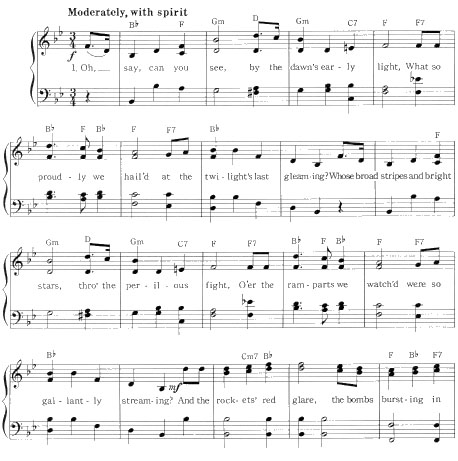
National flags are not merely symbols of a
country. Their colors and designs convey past history and future
goals. Flags have powerful connotations. They speak to the people and
politicians. People of one country will burn the flag of another with
whose politics they do not agree. To show their anger, students
display their own nation's flags with the design altered or cut out
completely. Dictators fly flags; dissidents rip them down. In every
country of the world, the treatment of a flag displays an opinion or
statement.
Americans take the treatment of their flag seriously and in the
20th century this has become an important issue. Included in the code
of ethics are such rules as the national flag cannot be used for
advertising. It cannot cover a monument or any ceilings. It must not
be folded while being displayed. No one should write on an American
flag. Ships can lower their flags slightly in greeting each other, but
otherwise should not be dipped for any other object or person.
In the late 1960s, American students wore small flags sewn to the
back of their jeans, symbolically insulting the American government
and protesting its involvement in the Vietnam War. They burned the
American flag in front of the Capitol Building in Washington as a
statement of protest. In the early 1990s, senators suggested an
amendment to the Constitution that would make this treatment of the
flag illegal. The proposition was opposed because many others felt
that this change would be a violation of Americans' constitutional
rights to express their opinions freely.
For all the controversy it is interesting to point out that the
United States did not even have a standardized flag until 1912! Called
the "Stars and Stripes," or "Old Glory," the flag is one of the most
complicated in the world. No other flag needs 64 pieces of fabric to
make. The current flag has 13 red and white alternating stripes
(representing the original 13 states) and 50 stars (each star
represents one of the states of the Union) on a blue background.
The American flag has also changed designs more than any other flag
in the world. The first flag, called the Grand Union, was first flown
at the headquarters of the Continent Army on January 1, 1776. Betsy
Ross, a' seamstress, is said to have contributed to this design. She
had an upholstery business which made flags for navy ships in
Pennsylvania. A legend still persists that she showed George
Washington how to make a five-pointed star and suggested thirteen
stars in a circle for the first flag. Her descendants claimed that she
offered the design. Actually, she and George Washington never met!
George Washington did design the Grand Union but an often-quoted
remark attributed to him might not be true:
| We take the stars from heaven, the red from our mother
country, separate it by white in stripes, thus showing that we
have separated from her... |
|
| On June 14, 1777, the Continental Congress proposed that the
United States have a national flag instead of the British Union
Jack. The 13 stars of the flag represented the 13 new states.
There were few public ceremonies honoring the Stars and Stripes
until 1877, when on, June 14, it was flown from every government
building in honor of the centennial of the adoption of a
national flag. Schools had unfurled American flags over their
doors or outside the buildings long before this; but in 1890,
North Dakota and New Jersey made a law that required their
schools to fly the flag daily. The first official Flag Day was
observed in Philadelphia, Pennsylvania in 1893. New York also
proclaimed June 14 as Flag Day 1897. Other states were slow to
follow. Some people thought that the day was too close to
Memorial Day and Independence
Day. |
In August 1949, President Harry S. Truman proclaimed June
14* as Flag Day. Since then the President proclaims the
commemoration yearly, and encourages all Americans in the country to
display the Stars and Stripes outside their homes and businesses.
Individual states determine how they will observe the day. In
Pennsylvania and American Samoa it is a public holiday. Usually the
flag is flown from all public buildings, speeches are made in public
places and ceremonies take place in towns or cities
*In
American Samoa Flag Day is celebrated on April 17th.
Elementary school children across the nation make The Pledge of
Allegiance in front of the flag every weekday morning:
| I pledge allegiance to the flag of the
United States of America, and to the republic for which it
stands, one nation, under God, indivisible, with liberty and
justice for all. |
During the War of 1812 between the British and Americans, lawyer
Francis Scott Key was escorting a prisoner to freedom by ship when he
saw an American flag surviving a battle in Baltimore Harbor. The flag
inspired him to write the poem which provides the words for the
national anthem. The actual flag now hangs in the Museum of American
History in Washington, D.C.. Today the "Star-Spangled Banner" is sung
at large public gatherings such as sports events. Many television
stations play the anthem before the station closes down for the
night.
The
Star-Spangled Banner
The National
Anthem |
| |
Oh, say can you see, by the dawn's early light,
What so proudly we hail'd at the twilight's last gleaming?
Whose broad stripes and bright stars, thro' the perilous
fight,
O'er the ramparts we watch'd were so gallantly
streaming?
And the rockets' red glare, the bombs bursting in
air,
Gave proof thro' the night that our Flag was still
there.
Oh, say does that Star Spangled Banner yet wave,
O'er the land of the free, and home of the brave? |
|
 |
 |

